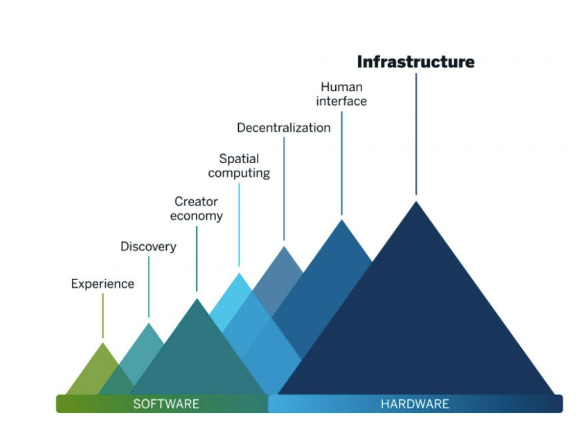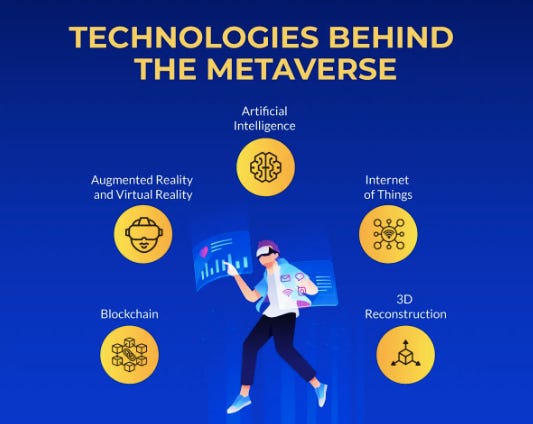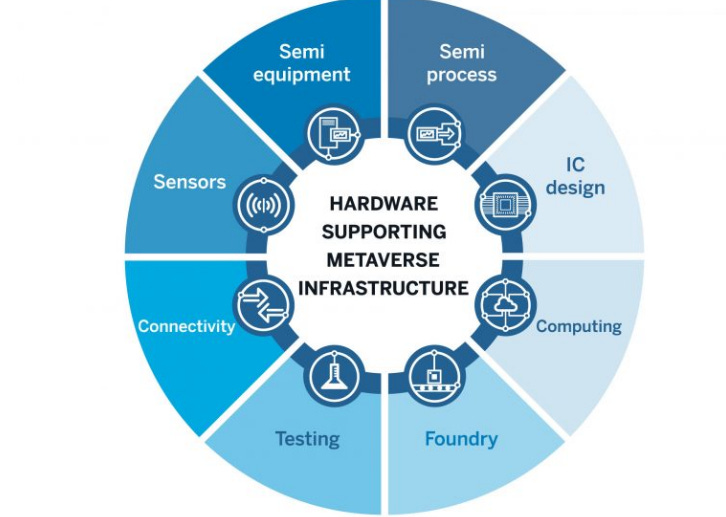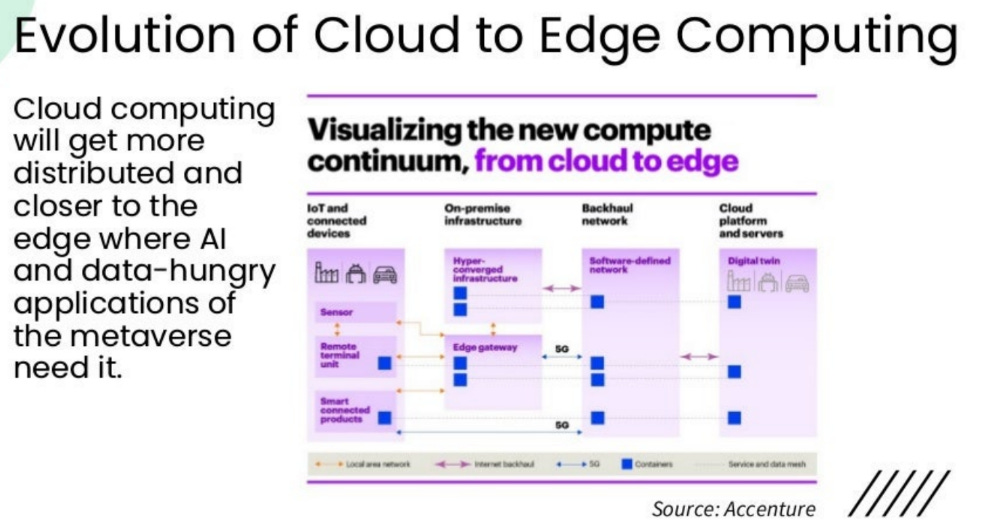Issue #14 - Layer 7: Infrastructure
The Metaverse is undoubtedly the second most well-known and universally recognized chunk of the Web3 ecosystem, just behind cryptocurrency. The explosion of this technological paradigm happened for two reasons - first being the record-breaking sales of digital real estate, followed by the name change of Facebook to Meta by Mark Zuckerberg.
This sudden move by the tech giant triggered a frenzy with millions of people running to Google and understanding more about this major pivot. When we talk about the Metaverse, it is natural to assume that big shots like Decentraland, Sandbox, Meta are the only big players in the Metaverse. But, numerous additional layers go far deeper.
There are seven layers to explore, and we're going to walk through the last of it all.
Layer 1: Experience
Layer 2: Discovery
Layer 3: Creator Economy
Layer 4: Spatial Computing
Layer 5: Decentralization
Layer 6: Human Interface
The seventh layer is known as the ‘Infrastructure’ and consists of technologies that make previous ideas a reality.

It needs a capable 5G infrastructure to enhance network capacity and reduce network congestion and latency. Check out the evolution of networks to today’s 5G and the future of 6G that will play a key role in supporting the metaverse.

Furthermore, to ensure that the devices indicated in the human interface layer function properly, devices need components like semiconductors, microelectromechanical systems (MEMS), and tiny, long-lasting batteries. Artificial Intelligence (AI), Wi-Fi, the blockchain, cloud architecture, and graphics processing units are some examples of technologies that empower the Metaverse.
This layer is what is needed to create a fully functional and interoperable metaverse.
To briefly sum it up, five technology clusters are required to power the metaverse:
The network and computational power, includes virtual scene fitting, edge computing, GPU servers, real-time network transmission, and spatial positioning algorithms
Video gaming technologies, comprising 3D game engines like Unreal Engine and Unity, for the creation of resources such as animations, sounds and images

Display technologies like AR, VR, MR, ER, and XR may adapt the user experience to their evolving likes and preferences over time in addition to providing an immersive audiovisual experience.
Blockchain technology – supported by decentralized value transfer mechanisms, settlement platforms and smart contracts to ensure value ownership and circulation.
Artificial intelligence
When it comes to hard technology, the metaverse swings on the foundation of powerful computers, integrated circuits, network equipment, communication components, advanced display systems, precision freedom optical systems and mixed reality equipment as well as sophisticated, high-resolution cameras.

Is the infrastructure layer developed enough to support the metaverse?
While the above-mentioned seven layered explanation is good enough for a general understanding, it seems like there is still a lot of scope to learn about the metaverse.
And, if the metaverse is going to become the next big sensation and transformational as the internet and mobile wireless networks before it, businesses or enterprises vying to enter it must ask themselves some serious questions about how they’re going to get there.
The metaverse is the future, and it can’t be achieved and experienced using yesterday’s IT infrastructure. It will require enterprises to break free from the traditional approach to IT and replace it with a modernized, distributed digital infrastructure, to be able to deliver the true promise of the metaverse
For example: To put two people in a social situation in a completely virtual environment, consider what is necessary: convincing and detailed avatars with realistic clothing, hair, and skin tones - all rendered in real time and based on sensor data capturing real world 3D objects, gestures, audio, and much more; data transfer at super high bandwidths and extremely low latencies; and a persistent model of the environment, which may contain both real and simulated elements. Imagine fixing this issue on a massive scale for hundreds of millions of people at once, and it will become clear that the current state of our computing, storage, and networking infrastructure is insufficient to support this ambition.
Raja Koduri from Intel stated that “scaling persistent, immersive, real-time computing globally to support the metaverse will require computational efficiency 1,000 times greater than today’s state of the art can offer”
To actually render avatars in a virtual world and allow millions of users to interact with objects and other avatars in that virtual world—all in real time—it’s going to require tons of data to be captured, transmitted, analyzed and acted upon with extremely low latency. A lot of companies have run successful demos and small numbers of early adopters, but there’s a long way to go and still a lot more to do before the metaverse can go mainstream.
The metaverse is the future & that future depends on digital infrastructure
According to SkyQuestt, the Global Metaverse Infrastructure Market was valued at USD 147.2 billion in 2021, and it is expected to reach a value of USD 1,368.3 billion by 2028, at a remarkable CAGR of 37.5% over the forecast period (2022-2028).

This market analysis and forecast is a proof of the fact that an optimized digital infrastructure that interconnects physical and virtual compute, storage and networking capabilities, along with advanced applications and cloud services is what exactly the metaverse needs to become the next big thing.
There are three components of digital infrastructure and each of them has a role to play in enabling the metaverse.
The Digital Core: Moving past the silos
Traditional IT architectures were built on centralized, segregated data centres; all transactions, regardless of where they originated, went via these data centres. The digital core of today is different: just a few essential workloads must be installed on-premises at the core, and even these on-premises systems can be cloud adjacent, enabling them to swiftly and easily access revolutionary cloud services. Additionally, digital core environments support OPEX models, which can aid businesses in balancing their financial reality with their metaverse aspirations.
The Digital Ecosystem: Collaborate and coordinate
The task of creating the metaverse is too great for one business to ever consider taking it by itself. An ecosystem of partners working together will be necessary to deliver the capacities and capabilities the metaverse requires. This ecosystem will consist of network service providers that help break down bottlenecks and virtualize crucial functions, cloud service providers that help fast scale, compute, and enable rapid, reliable data migration, and vendor-neutral interconnection partners who bind everything together.
The Digital Edge: Meeting users at the edge
A crucial step toward making the metaverse a reality is the deployment of digital infrastructure at the edge. The edge sites serve as the link between the virtual and physical worlds, and businesses set up infrastructure there to be as close to users as feasible.

Moving data back and forth between users and centralised IT hubs results in unacceptable delay when data sets are as huge as those produced by the metaverse. Data can stay local thanks to edge infrastructure, keeping latency under control.
It is important for the metaverse supporters to not assume that the necessary infrastructure upgrades will simply fall into place as the natural result of technological progress. Instead, enterprises must take the opportunity and initiative to deploy a metaverse-ready digital infrastructure and be proactive about making it happen.
Key Takeaway
The Metaverse has a solid base, and technology is developing quickly. Are we in for another decade-long Netflix search? Most likely not.
There is a tonne of room for creativity when the biggest names in technology collaborate. The development of tools and cloud infrastructure by new businesses is already underway in order to make it possible to create appealing and scalable 3D apps.
Built-in compression and poly-reduction techniques are necessary for infrastructure for 3D Metaverse content in order to dynamically stream 3D assets under various network conditions. The technology we rely on will significantly advance thanks to 5G, which will also help with latency problems. And the future that will have 6G power the metaverse is also just round the corner.
About Rising Capital
As Rising Venture Studio, we promote the entrepreneur and the company building process. We know what it’s like to be in the founder’s shoes and support the ‘next big thing’ in crypto, metaverse or gaming with apt resources and network.
As the Rising Capital Fund, we invest in early-stage crypto companies across the NFT, Gaming and Metaverse Sectors, while keeping a portion of our portfolio in liquid assets. We strive to take a fundamental approach to identify unique investment opportunities in the emergent and evolving crypto asset class.
If you are looking for any help in terms of technology, networking, funding or anything else for your business venture, apply here.
You can learn more with us by subscribing to our resources here:
Website | Telegram | Linkedin | Twitter | Rising Cap Weekly & Monthly Reports



